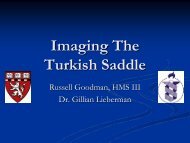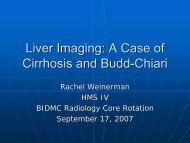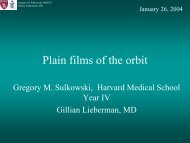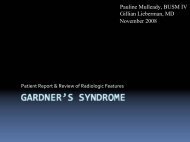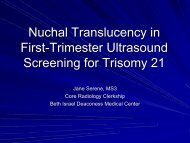The Basics of MRI: T1 vs. T2
The Basics of MRI: T1 vs. T2
The Basics of MRI: T1 vs. T2
You also want an ePaper? Increase the reach of your titles
YUMPU automatically turns print PDFs into web optimized ePapers that Google loves.
Frank Minja, HMS III<br />
Gillian Lieberman, MD<br />
Proton (Spin) Density Weighting<br />
• <strong>The</strong> signal depends on the number <strong>of</strong> spinning protons<br />
• <strong>The</strong> greater the density <strong>of</strong> protons = the stronger the signal<br />
• <strong>The</strong> smaller the density <strong>of</strong> protons = the weaker the signal<br />
• A Long TR repetition time will blunt the <strong>T1</strong> signal<br />
• A Short TE echo time will blunt the <strong>T2</strong> signal<br />
• By default contrast must now depend on the proton density<br />
• Differences in proton density = contrast!<br />
• Proton (Spin) Density weighting = Long TR + Short TE<br />
• TR = 1500 - 3500 ms<br />
• TE = 20 -35 ms<br />
16



